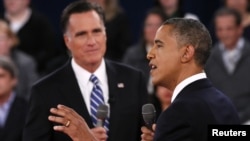U.S. President Barack Obama and Republican challenger Mitt Romney held the second of three nationally televised debates on Tuesday. The two debated issues including the economy, energy and foreign policy during a town hall-style meeting at New York's Hofstra University.
Jennifer Sclafani is a visiting professor of linguistics at Georgetown University in Washington, D.C. She says the debate was very different from the first presidential debate two weeks ago.
"Last night I would say that we really saw the president back on offense and taking control of the floor, both figuratively and literally. And of course Romney was also quick on offense and concise in outlining his own position for most of the debate. So he described very succinctly what he saw were weaknesses or broken promises in the president’s performance," she said.
Professor Sclafani says the linguistic style and communication displayed was only one of the things that set this debate apart from the last one.
“Even more than linguistic style, some of the differences that really stood out to me were actually non-linguistic. Here we had a town hall format in which questions were fielded from the audience and candidates were not physically confined before a podium as they were in the last debate," she said.
She says this allowed the candidates more freedom to walk around and to engage with the audience and each other. And she says it resulted in some heated non-verbal exchanges.
“The candidates didn’t just get in each other’s conversational space by interrupting each other, but they actually got in each other’s physical space. If you had muted the volume on the debate their movements across the stage were almost reminiscent of a boxing match. So you saw them engaging in this non-verbal physical dance throughout the debate. And it was very obvious in terms of their physical movements when they were being verbally aggressive towards each other because you could see it reflected in their physical movements," she said.
Although the president’s demeanor and the physical layout of the debate stage were major points of difference between the first and second debates, one verbal comment by Mitt Romney did seem to take on a life of its own on social media, picking up thousands of responses on Twitter, Tumblr and Facebook.
Romney was responding to a question from a female audience member about pay inequality in the workplace. He said that during his time as governor of Massachusetts, he had worked with women’s groups to help him find qualified women to fill cabinet positions on his staff.
“I went to a number of women's groups and said, "Can you help us find folks," and they brought us whole binders full of women," he said.
Professor Sclafani explains what Mitt Romney meant by “binders full of women.”
“That reference to binders of women, when I first heard it I thought of an actual three-ring binder that had several resumes from women that he was looking through when choosing leaders in his team," she said.
She says there are a couple of reasons that the comment may have received such a negative response.
“Many people took offense to the use of this term for two reasons. This idea of connecting binders and women together can either objectify women or take away their humanity and just present them as pieces of paper that are bound in this physical folder," she said.
She also says the wording also brings to mind the discourses of feminism and the women’s movement in the United States.
“I think many people, especially women, perceived this specific choice of word[ing] of “binders of women,” as being reminiscent of an idea that women are actually bound in society, and they are not free," she said.
One social media user tweeted that in order “to solve the problem of pay inequality we don’t need more ‘binders full of women.’ We need more ballots full of women.”
More to Presidential Debate Than Issues
- By June Simms
